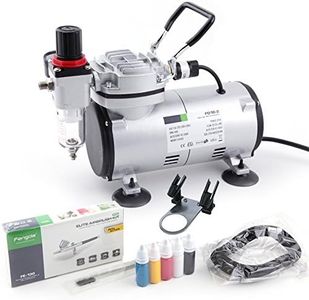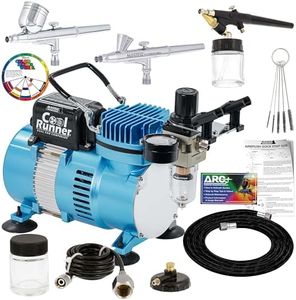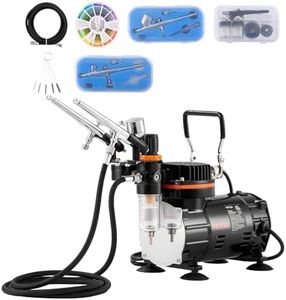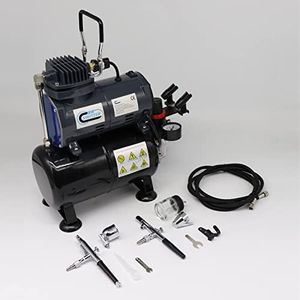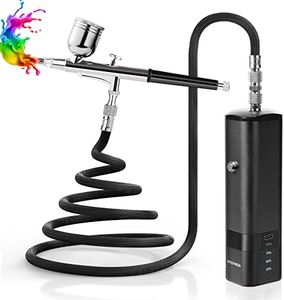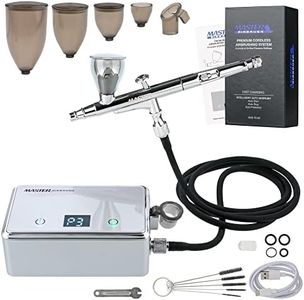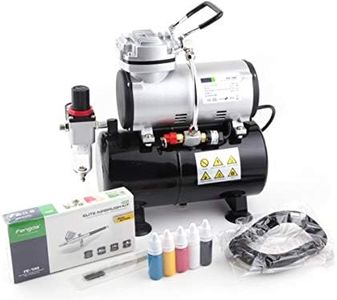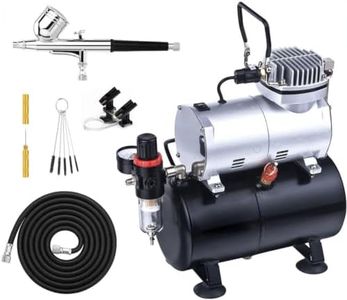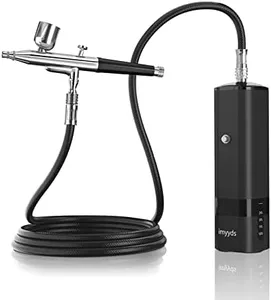We Use CookiesWe use cookies to enhance the security, performance,
functionality and for analytical and promotional activities. By continuing to browse this site you
are agreeing to our privacy policy
10 Best Airbrush Compressor Kits
From leading brands and best sellers available on the web.By clicking on a link to a third party's website, log data is shared with that third party.
Buying Guide for the Best Airbrush Compressor Kits
Choosing the right airbrush compressor kit can make a big difference in your art, hobbies, or small painting projects. The ideal compressor should match what you plan to use it for, whether that's fine art, model painting, makeup, or cake decorating. Taking the time to learn about the key features will help you find a kit that's powerful enough for your needs, quiet enough for your workspace, and reliable over time.Air Pressure (PSI)PSI stands for Pounds per Square Inch and measures how much air pressure the compressor can deliver. This is important because different airbrushing tasks need different amounts of pressure. For delicate tasks like makeup or cake decorating, lower PSI (10-20) is usually enough and gives you more control, while thicker paints or larger surfaces might require higher PSI (20-40 or more). To choose the best range for you, think about the materials you’ll use and the sizes you’ll work on—lower for fine, detailed work, higher for broader coverage or thicker paints.
Air Flow (CFM or L/min)Air flow, often measured in liters per minute (L/min) or cubic feet per minute (CFM), shows how much air the compressor can push. This matters because a higher air flow allows you to spray continuously without interruptions, which is great for bigger projects or if you paint for long periods. For small, detailed work, a lower air flow is usually fine, but for larger surfaces or frequent use, look for higher air flow specs so your compressor doesn’t need to rest as often.
Noise LevelCompressor noise is measured in decibels (dB), and it tells you how loud the machine will be. If you plan to use the compressor indoors, at night, or in shared spaces, a quiet model (around 40-50 dB) will be much more pleasant and less disturbing to others. If you’ll be using it in a workshop where noise isn’t an issue, this may be less important. Think about your setup and choose a noise level that suits your environment.
Tank vs. TanklessSome airbrush compressors have an air tank, which stores compressed air and helps deliver a smoother, more consistent airflow, while others are tankless and run continuously. Tanks can prevent pulses and provide steadier spraying, which is important for professional-looking results, but they make the unit larger and heavier. For portability or short, simple jobs, a tankless model can be easier, while for longer, high-quality sessions, a tank-equipped compressor is often better.
Duty CycleThe duty cycle tells you how long the compressor can run before it needs to rest to prevent overheating. For example, a 50% duty cycle means it can run for 10 minutes and then needs 10 minutes to cool off. If you’ll use the compressor for long projects, look for a higher duty cycle, which means more uninterrupted work. For quick touch-ups or shorter sessions, a lower duty cycle is usually sufficient.
PortabilityPortability is about the compressor’s size and weight. If you need to move your airbrush kit between locations or have limited space, a lightweight and compact model is more convenient. If your compressor will stay on a table in a dedicated studio, you can go for a larger model with more features. Consider how and where you'll use it before deciding how important portability is for you.
Accessories and CompatibilityAirbrush compressor kits can come with different accessories like hoses, airbrushes, moisture traps, and adapters. It’s important to check that the kit is compatible with the airbrushes you use or plan to use. Having included accessories can make it easier to get started, but make sure they're good quality and match your needs. If you already have an airbrush or plan to upgrade, ensure the connections match or that adapters are available.


